|
|
La! La! La! Today Little Tangerine will take you to fruit picking!
Our teacher helped us reserve the schedule of picking citruses and invite
Leader Gu of Dakeng’s fruit marketing team to be a presenter for us. He
was very familiar with Dakeng’s plants and agricultural products. He was
expert in the plentiful natrual ecology. On the way to the fruit garden,
he could tell us much splendid knowledge concerned with the flowers and
trees we met such as bamboo shoots, Custuta, Mikania micrantha, alocasia
odora and oranges. He let us know that there are still numerous plants
waiting for us to understand and
appreciate in the nature.
|
|

|
Activity’s subject:
|
Pick fruits happily
|
|

|
Activity’s place:
|
Leader Mingjia Gu’s Citrus Garden
|
|

|
Date & Time:
|
8 a.m., Thursday, November 30th,
2006
|
|

|
Activity’s content:
|
Pick citrus
and the ecological guidance of citrus and bamboo shoots
|
|

|
Attending members:
|
Sihen Chen, Yiling Ke, Yawen Lin, Yinsyuan
Liao, Yajhu Hu, Yijie Huang, Shuyuan Jhang,Weiling Chen, Zihsing Huang, Teacher Huijhen
Cai, Teacher Bijhu Li, Teacher Peishan Cheng
|
|

|
Activity’s process:
|
|
As soon as we arrived at the schoolwe all lined up to get on the bus. After we arrived our destination, Uncle Gu kindly picked us up by himself. Because the road
was too narrow for driving, we got off the bus and hiked to the
mountain. Uncle Gu pointed at green roof and said,” The shorter house
beside the green roof is my house.” Well, it didn’t look far, so we took
hiking as an exercise.
Seeing the beautiful view along the way, we saw a lot of citruses
at the far. Everyone yelled
happily, but Uncle Gu told us they were all oranges. How come they looked
alike? Uncle Gu pointed to a scrap of paper and let us guess what it was
and its function. Originally it was a flycatcher. Beacause the drosophila especially liked yellow
and carophyllene, so the fruit farmers applied it on the paper first,
pesticides later and finally completed the flycatcher.
Walking out of the orange garden, Uncle Gu was busy introducing us
mango trees, banana trees and cordia dichotoma, which was unsually seen
in winter. No wonder he was the leader of the fruit marketing team.
|
|
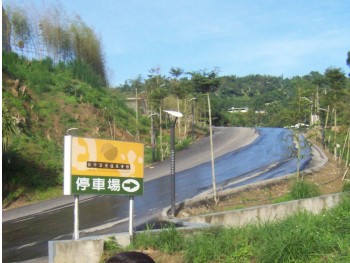
Walked
to Uncle Gu’s fruit garden.What
an excellent view!
|
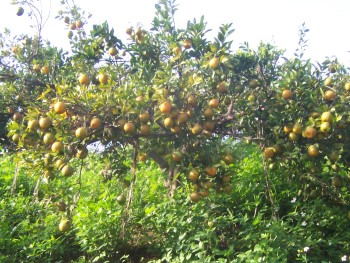
This
is a citrus instead of an orange !
|
|
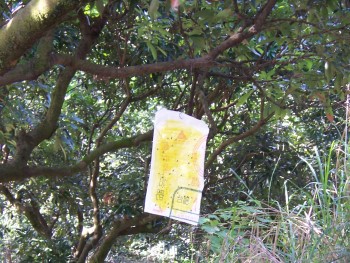
The
homemade flycatcher hanging on the tree.
|
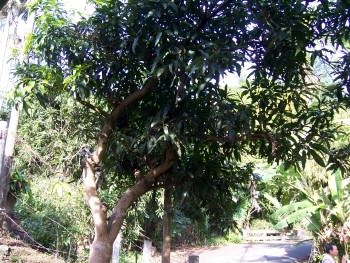
This
is a mango tree.
|
|
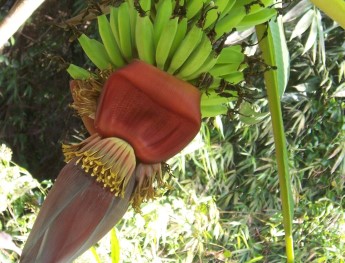
Beautiful
bananas
|
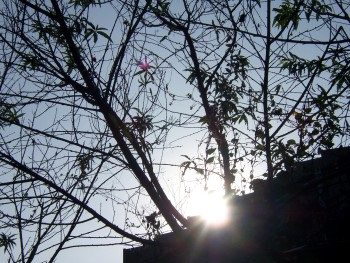
The
peach tree also bloomed a flower under the sunshine.
|
 The
ecological catastrophe of Cuscutae and Mikania micrantha The
ecological catastrophe of Cuscutae and Mikania micrantha |
|
Uncle Gu pointed to the destroyed rock by the bridge and told us it
was caused by the 921 earthquake. He also pointed to a yellow plant like
a spider’s web and said, “ This is Cuscutae and the white one is Mikania
micrantha. The Mikania micrantha looks white when it is blooming, but it
is the bane of agricultural products.” Cuscutae survives by attaching the
trees and plants. It will suck the nutrition from the plants on the tree
and finally cover the whole plant to keep the plant from
photosynthesizing. Mikania micrantha is like Custuta. These two kinds of
plants can’t remove easily. In additon, their seeds will spread away by
wind and occur the ecological catastrophe.
|
|
Question:
|
What is Cuscutae? How does it
afftect other plants?
|
|
Answer:
|
Cuscutae will bring the ecological catastrophe in the
future. It can live without the dirt, so it is also called “ cassytha.”
It attaches the plant with a formidable life, so it is very difficult to
get rid of and threats other plants’ life.
|
|
Question:
|
Is it possible to get rid of Mikania
micrantha completely?
|
|
Answer:
|
Mikania micrantha is also difficult to get rid of. Even
though it is not troublesome as Cuscutae to take away, its seed will
spread by wind. It is difficult to clean Mikania micrantha at one time.
In the fruit garden, special people likely clean it thorooughly, but it
is impossible to do it in the field.
|
|
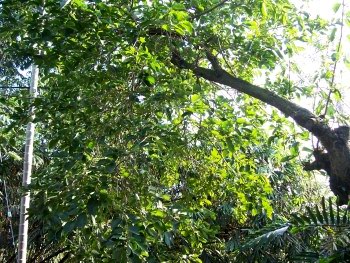
This
is the stuff for grandma’s congee.
|
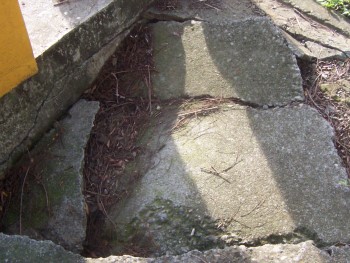
You
can found the ruin by the bridge for the 921 earthquake.
|
|
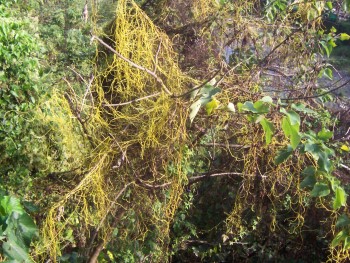
The
Cuscutae covered the whole agricultural product.
|
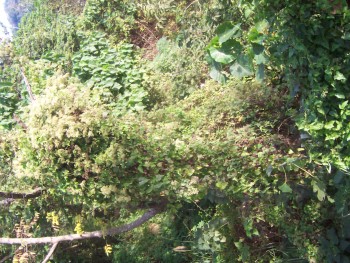
Mikania
micrantha can also cover the whole agricultural product.
|
 Bamboo
shoots Bamboo
shoots |
|
Question:
|
Can you introduce the appearance of
Thorny bamboo?
|
|
Answer:
|
There is no thorn on it at the first sight, but there are
many small thorns on its root. In the agricultural society people used to
take it as the construction material or the carrying pole, or whatever.
Finally peole can recycle it for making paper.
|
|
Question:
|
When does the bamboo shoot end its life?
|
|
Answer:
|
At the bottom of the bamboo shoot are small slices of the leaves.
That means it is the time to produce bamboo shoots but it is almost the
end of its life.
|
|
Question:
|
When does it produce ?
|
|
Answer:
|
Well. Uncertainly. Sometimes it needs to plant for four or
five years and sometimes it would produce soon after the harvest.
There
are two big bamboo problems—one is the blooming and the other is a poison
disease commonly called “ bamboo shoot tack,” which is the black tough
spot in the bamboo shoots.
Take a look! The joints of the bamboo are the place to produce
bamboo shoots. Each maternal bamboo must be left for producing more than twenty
bamboo shoots from its both sides.
|
|
 Bamboos must《Leave
Three, Remove Four, Abandon Seven》 Bamboos must《Leave
Three, Remove Four, Abandon Seven》
|
|
Uncle Gu introduced us the kinds and characteristics of the plants
attentively. He let us understand that there are so many plants in Dakeng
and the harvest period of the citrus in the soutern Taiwan is earlier
than the central Taiwan. Uncle Gu spoke out one Taiwanese phrase
freely--“Leave three, Remove four, Abandon seven.” It was so insightful. Everone was
dmbstruck after hearing that. It
means the bamboo shoots can keep in the third year, but they must chop
down in the fourth year. In the seventh year, they are all abandon for
the useless. Uncle Gu said the place to produce bamboo shoots is on the
joits. They will still keep producing after chopping. The stock must be
left so that its both will keep producing continually. On bamboo can
produce twenty bamboo shoots at one harvest time. Uncle Gu still told us
to cover black cloth on bamboos to prevent the water in bamboo shoots
from evaporating and yielding grass. This way can save many human resources
and make bamboo shoots better. This is really the treasure from farmers’
experienced intelligence.
|
|
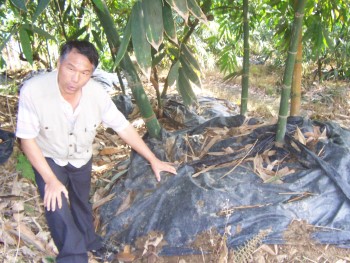
Bamboo
shoots must be covered with the black cloth.
|
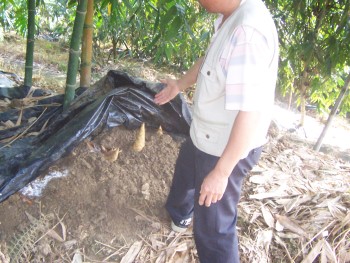
This
is the bamboo shoot.
|
|
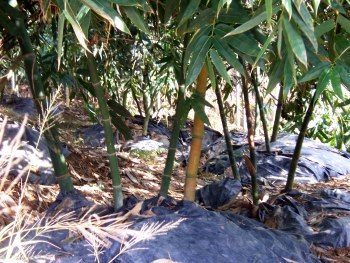
Yellow
bamboo refers to the third year.
|
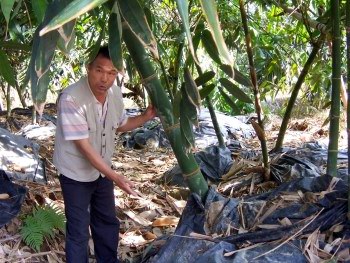
This
is a stock.
|
|
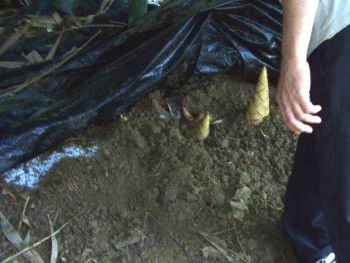
Wow!
We saw the bamboo shoots.
|
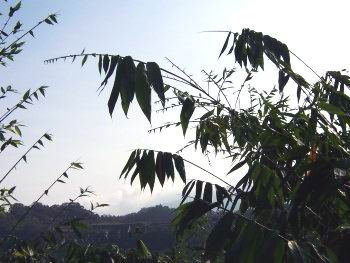
The
bamboo is producing.
|
 Bitter
seed Bitter
seed |
|
Question:
|
Eh... What is that black round stuff?
|
|
Answer:
|
Guess.
|
|
Question:
|
What is it for a tiny seed?
|
|
Answer:
|
Well. That is a bitter seed, the material
for the tea seed oil. After bearing a baby, the woman needs it to nourish
the body in the postpartum rest and recuperation.
|
 Green
citrus and stored citrus Green
citrus and stored citrus |
|
Question:
|
How come there is a board on the citrus tree?
|
|
Answer:
|
Because the citrus is afraid of
raining, then it is not scared anymore.
|
|
Question:
|
Why is the citrus afraid of raining?
|
|
Answer:
|
Because the ripe citrus’ skin is thin
and fragile, it is afraid of getting hurt by water. That’s why it is so
afraid of raining.
|
|
Question:
|
Is the harvest time of the citrus
here as the same as the other place?
|
|
Answer:
|
The southern citrus is ripe earlier.
The ripe time in the central Taiwan is almost the same. But the green
citrus is sold now.
|
|
Question:
|
What is the green citrus?
|
|
Answer:
|
The green citrus means the premature
citrus starts to be sold. Some fruit farmers store the citrus after harvesting
and sell it after Chinese New Year for the better selling price.
|
 Useful wild
taro in the field Useful wild
taro in the field |
|
Question:
|
What
is that big leaf like a taro?
|
|
Answer:
|
Oh.
That is wild taro.
|
|
Question:
|
What is the wild taro for?
|
|
Answer:
|
Its juice belongs to alkali. If you were
stung by insects or bees, you can apply it. Sometimes you can use its
leaf to keep out rain or to be a pad.
|
|
Question:
|
Is the taro of the wild taro
eatable?
|
|
Answer:
|
Some people eat it. The aboriginal
would cook it for surviving in the mountains. They have to cook many
times for it is poison, at least four or five times. In addition, people
need to pour the water out for each time to remove the poison so that they can start to eat.
|
|
Question:
|
Is its taro very big?
|
|
Answer:
|
The roots of the wild taro are mostly
on the ground, rarely under the ground. Its root is very thick and attach
to the ground fixedly.
|
|
Question:
|
Can the wild taro bloom?
|
|
Answer:
|
It can also bloom, but the flowers are
not beautiful.
|
|
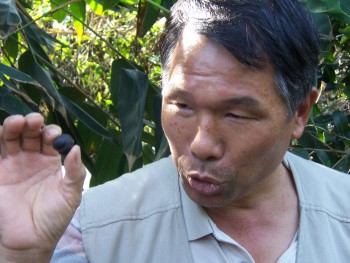
Guess
what? Originally it is a bitter seed.
|
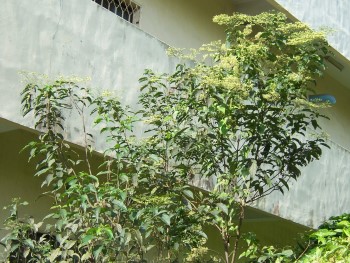
The
excessive bright red banlangen during the SARS period
|
|
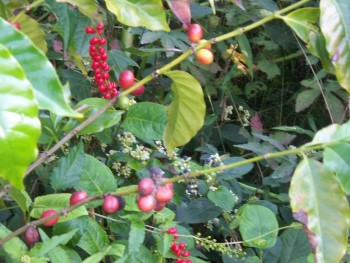
Coffee
beans
|
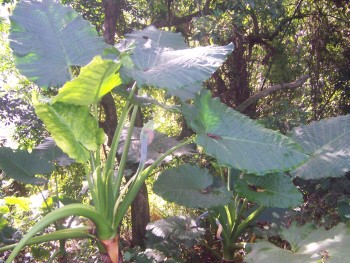
Poison
wild taro
|
|
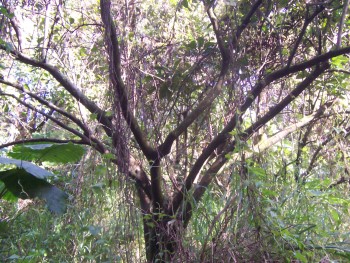
The
pomelo tree
|
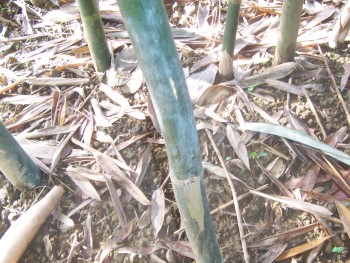
This
is the green bamboo shoot
|

|
Finally we could start to pick the fruit. Everyone tried to look
for the biggest and the reddest citrus everywhere. I eventually found a
fat and red citrus, so I pulled the citrus directly. Uncle Gu said, “
Don’t hurry. Be patient. There is a correct way to pick the citrus to
keep it from being destroyed.”
We had to pick the citrus with its stem about
two centimeters and the seveal leaves on it. If we didn’t follow this direction,
then ants would eat it from the hole of the stalk. Therefore, I decided
to pick another citrus and must follow Uncle Gu’s direction this time.
After several minutes, everyone’s hands were full of the big citruses. We
couldn’t wait to peel them. It
really tasted sweet after taking a big bite!
|
|
 Uncle Gu taught us the correct steps to pick
the citrus as the followings. Uncle Gu taught us the correct steps to pick
the citrus as the followings.
|
|
1.
|
Aim the target firstly : Choose the the color
of the fruit skin which turns into the glisteningly yellow. If the bottom area is bigger, the fruit skin is rough
and it feels heavy while holding it, then it is the fleshy and juicy citrus.
|
|
2.
|
The correct way to pick the citrus: One hand holds the citrus
and the other scissors it’s stalk above two centimeters.
After picking the fruit, cut the stalk flat with the scissor.
Never pull or grap the fruit lest harm the fruit tree or the citrus.
|
|
3.
|
Place
the citrus in the shaded area with the air. It is because the citrus
would still respire and have metabolism after being picked, so the higher
temperature it has in the place, the yellower the citrus will become. In
addition, the vatamin C in it would lose more quickly. If place the
citrus in the shaded area, then its flesh will taste sweeter and more
delicious.
|
|
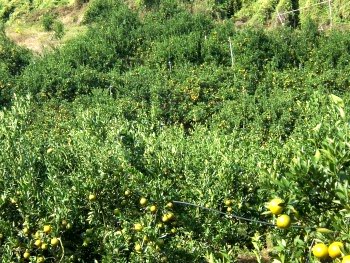
We
saw the citrus abounded in the mountains and the valleys.
|
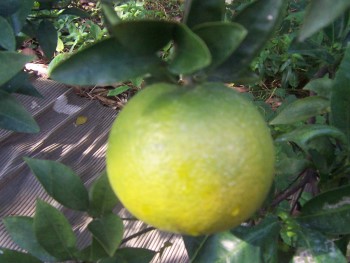
This
is the citrus-Ponkan. The harvest is duringChinese
New Year.
|
|
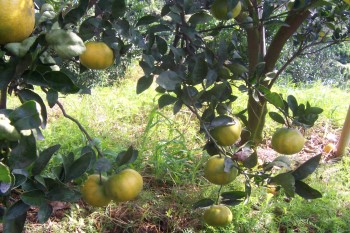
The
citrus-Maogu produced less.
|
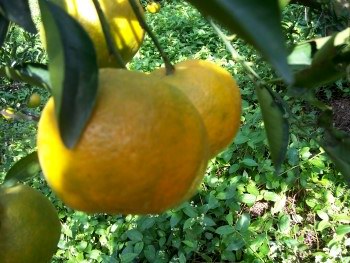
It’s
the productive period of the citrus-Ponkan.
|
|
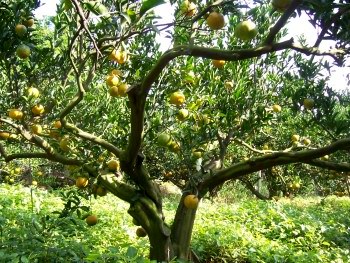
The
beautiful citrus tree.
|
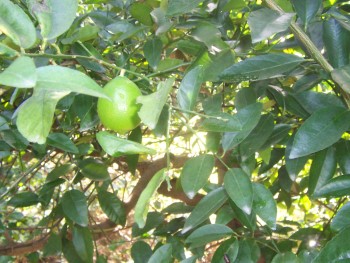
This
is neither the citrus nor the lemon but the lime.
|
|
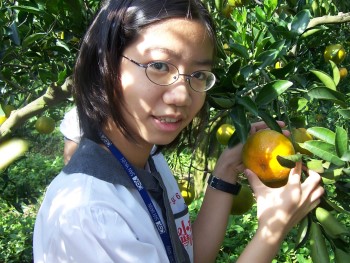
This
is so red that it must taste very sweet.
|
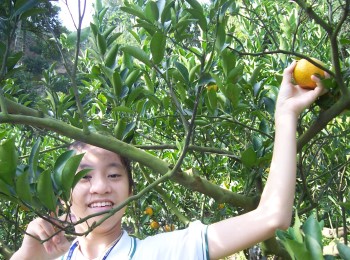
I
wanted this one.
|
|
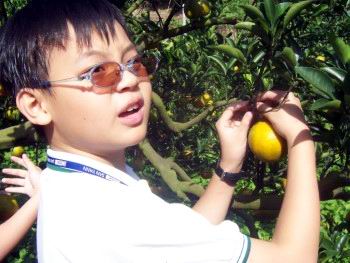
Uncle
Gu, did I pick right?
|
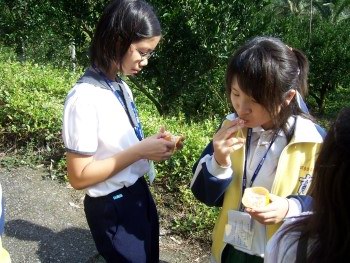
Took
a bite quickly. Wow! It’s so sweet.
|
|
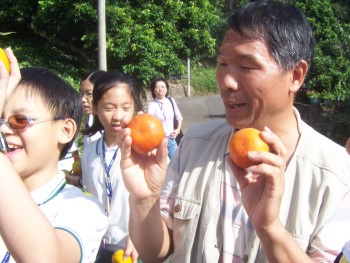
This
is the new type—“Goregeous red.”
|
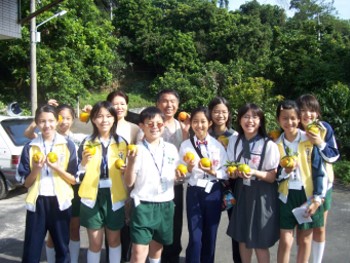
I
hold a citrus by myself and took a picture with Uncle
Gu.
|

|
The
learning remarks of “Dakeng soybean sauce” team
|
|

|
Sihen
Chen
|
Remember to “eat readily after picking.” It
was great! It was super juicy!
|
|

|
Yiling Ke
|
The citrus tasted sweet and delicious. You
must regret if you don’t eat it! Bravo! It tastes more delicious if you
pick it by yourself.
|
|

|
Yawen
Lin
|
Dakeng’s citrus tasted sweet and enchanting.
Next time when you come to Dakeng, remember to pick the citrus first.
|
|

|
Yinsyuan
Liao
|
It was surprisingly that the banlangen could
prevent SARS. It is so magic!
|
|

|
Yajhu
Hu
|
Dakeng’s bamboo shoot is the most delicious.
Next time if you want to eat bamboo shoots, remember to think of Dakeng!
|
|

|
Yijie
Huang
|
In fact, I don’t like eating the citrus at
all. But Dakeng’s citrus is the exception because it has sweet flavor and
let people enjoy it so much as to forget to put it down.
|
|

|
Shuyuan
Jhang
|
I am used to eating the citrus. But it was the
first time for me to pick the citrus by myself. It was so touching.
|
|

|
Weiling
Chen
|
I felt sweeter after eating the citrus from the
fruit farmers’ attentive care.
|
|

|
Zihsing
Huang
|
I really like eating the citrus, especially
Dakeng’s citrus was unique delicious. Bravo!
|
|

|
Huijhen
Cai
|
The citrus picked by myself was the most
delicious and the most sweet.
|
|

|
Bijhu
Li
|
I felt the enjoyment of Taiwanese farmers’
harvest by their hard working when I saw the plentiful golden citrus.
|
|

|
Peishan
Cheng
|
After this fruit picking activity, the
children and I had a better understanding of Dakeng. It was really not
easy.
|
After
Uncle Gu’s splendid introduction to Dakeng’s ecology, I finally found that
there were so many plants, fruits and flowers etc. It was treasurable everywhere.
We tasted the delicous citrus and absorb more natural knowledge. It was
really a big harvest day.
Written
by Ya-Wen, Lin
|
